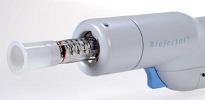|
|
||||||||||||||||
|
|
|
|
|
|||||||||||||
|
|
|
|
Safety Study of Flu Vaccination with a Needle-free Jet Injector
The threat of pandemic influenza (flu)* is likely to require mass vaccination campaigns in which a limited number of health workers would need to vaccinate large numbers of people quickly. Needle-free jet injectors have administered tens of millions of doses of influenza, smallpox, meningitis, and many other vaccines rapidly. Jet injectors reduce the dangers of needles, including reuse of non-sterile needles, needle-stick injuries to health workers, and unsafe disposal of sharps waste. Safety concerns about older injectors which used the same nozzle on consecutive patients have been overcome by a new generation of disposable-cartridge jet injectors (DCJIs). When flu vaccine is given between the layers of the skin (intradermally), a reduced dose of vaccine can often be as effective as a full dose. This might allow more people to be protected with expensive or scarce vaccines. The traditional intradermal vaccination method by needle and syringe can be difficult, time-consuming, and dangerous in some countries where unsterile reuse occurs. Jet injectors can give vaccines intradermally without these drawbacks. This study was the first phase of a clinical trial to determine the safety and immune response to reduced-dose flu vaccination by a DCJI fitted with an investigational spacer to place the vaccine intradermally. *Note: This study used the regular seasonal flu vaccine, not one made from a pandemic avian flu strain, but the results might apply to other strains which may threaten. Study Design The trial is being conducted in a dedicated study center at the Hospital Infantil Dr Robert Reid Cabral, a public, tertiary-care, pediatric teaching hospital in the capital of the Dominican Republic. In phase I, 48 children aged 6 to 23 months were randomly assigned to an experimental group or one of two control groups. Neither the researchers nor the children's parents knew which group each child was in.
On the day the vaccines were given and 2, 7, and 28 days afterward, a doctor recorded any reactions to the vaccine. Parents also wrote down any reactions in diaries on the day the vaccine was given and each day for a week afterward, and any problems in the succeeding three weeks. Results The trial has not yet been "unblinded," meaning the investigators still do not know which group each child was in. So the results are aggregated among all 48 children in phase I of the study. Most local reactions to the 96 investigational vaccinations (2 per child) were mild—
Systemic reactions occurred over a longer period of time and did not usually cluster in time. All were mild except one: a fever-related convulsion on day 24 after the first dose, which is not believed to be caused by the vaccination. The other systemic reactions included—
For detailed information about this study, visit ClinicalTrials.gov or abstract P25* (nominal page 80 [81 of 106]) presented at the 11th Annual Conference on Vaccine Research.
*Links to non-Federal organizations found at this site are provided solely as a service to our users. These links do not constitute an endorsement of these organizations or their programs by CDC or the Federal Government, and none should be inferred. CDC is not responsible for the content of the individual organization Web pages found at these links. **Note: Tradenames are mentioned for identification only, and do not imply recommendation or endorsement by CDC or the Department of Health and Human Services.
Page last reviewed: September 24, 2008
Page last updated: May 13, 2008 Content source: Immunization Safety Office | |||||||||||||||||||||||||||||||||||||||||||||||||||
|
||||||||||||
|